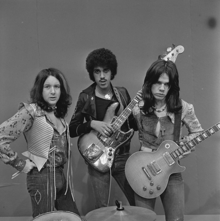Gary Moore
Influenced by Peter Green and Eric Clapton, Moore began his career in the late 1960s when he joined Skid Row, with whom he released two albums.
After Moore left the group he joined Thin Lizzy, featuring his former Skid Row bandmate and frequent collaborator Phil Lynott.
[2][4] After moving to Dublin, Robert William Gary Moore joined Irish blues rock band Skid Row.
"[14] Sebastian Bach, former frontman of the American heavy metal band Skid Row, claimed that Moore sold them the rights to the name in 1987 for a reported $35,000.
After the departure of guitarist Eric Bell, Moore was recruited to help finish the band's ongoing tour in early 1974.
"[3] In 1977, Moore rejoined Thin Lizzy for a tour of the United States after guitarist Brian Robertson injured his hand in a bar fight.
[33][34] After moving to London and signing a new recording contract with Virgin, Moore released his second solo album Corridors of Power in 1982.
[35] Musically Corridors of Power featured "more of a rock feel",[14] with additional influences from AOR bands such as Journey and REO Speedwagon.
[32] The album also featured former Deep Purple drummer Ian Paice, Whitesnake bassist Neil Murray and keyboardist Tommy Eyre, who had previously played with Moore in Greg Lake's backing band.
During the supporting tour for Corridors of Power, singer John Sloman was hired to share lead vocal duties with Moore and Eyre was replaced by Don Airey.
[13][36] In 1984, Moore released the album Victims of the Future, which marked another musical change, this time towards hard rock and heavy metal.
[39] In 1985, Moore released his fifth solo album Run for Cover, which featured guest vocals by Phil Lynott and Glenn Hughes.
Hughes was supposed to join the band on bass, but due to his substance abuse problems, he was replaced by Bob Daisley.
[13] A blend of Celtic folk music, blues and rock,[32] the album was another success, being certified platinum in Sweden,[43] gold in Finland and Norway,[47][48] as well as silver in the UK.
[51][52] While After the War achieved gold status in Germany and Sweden,[43][53] as well as silver in the UK,[54] Moore had grown tired of his own music.
He told former Thin Lizzy guitarist Eric Bell that after listening to some of his own albums, he thought they were "the biggest load of fucking shite" he had ever heard.
[52] The album's title track also became the only single of his solo career to chart on the Billboard Hot 100; it reached number 97 in February 1991.
"[58] In 2002, Moore collaborated with former Skunk Anansie bassist Cass Lewis and Primal Scream drummer Darrin Mooney in Scars, which released one album.
[66] Moore was buried in a private ceremony at St Margaret's Churchyard in Rottingdean which is in Brighton on the southern coast of England with only family and close friends in attendance.
Describing the show Moore said, "It was an amazing experience just to hear a guitarist walk on stage and plug into this amplifier, which I thought was a pile of shit, and get this incredible sound.
"[92] Some of Moore's other early influences were Jeff Beck, George Harrison, Jimi Hendrix, Hank Marvin, John Mayall and Mick Taylor.
[5][14][32] Brian Downey described him as "cranky" at times, while Eric Bell recalled a particular incident after a concert in Dublin: "I went to see him in the dressing room afterwards.
[66] While Moore acknowledged his reputation of being difficult to work with at times, he attributed that to his own perfectionism holding others up to the same standards he set for himself.
After his death, many of Moore's fellow musicians paid tribute to him including his former Thin Lizzy bandmates Brian Downey,[95] and Scott Gorham,[85] as well as Bryan Adams,[96] Bob Geldof,[97] Kirk Hammett,[98] Tony Iommi,[99] Alex Lifeson,[100] Brian May,[101] Ozzy Osbourne,[102] Paul Rodgers,[103] Henry Rollins,[96] Roger Taylor,[104] Butch Walker,[96] and Mikael Åkerfeldt[105] amongst many others.
[106] On 18 April 2011, Eric Bell, Brian Downey and a number of performers gathered for a tribute concert at Whelan's in Dublin.
[111] On 12 April 2019, a tribute concert for Moore was held at The Belfast Empire Music Hall to help raise funds for a memorial statue.
[128] In 2000–2001, Gibson released a Gary Moore Signature Les Paul Standard with a faded lemonburst finish and a reversed neck pickup.
[131] On Corridors of Power and Victims of the Future, Moore used a 1961 Fiesta Red Fender Stratocaster, which had previously belonged to Tommy Steele.
[13][132][133] During the 1980s, Moore also played Hamer and PRS guitars, as well as Charvels equipped with Floyd Rose tremolos and EMG pickups.
[13][89] After his death, several of his guitars were auctioned off including a 1963 Fender Stratocaster given to him by Claude Nobs, a Fritz Brothers Roy Buchanan Bluesmaster, a 2011 Gibson Les Paul Standard VOS Collector's Choice No.





